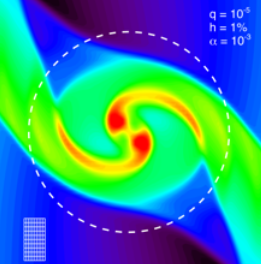
Clément Baruteau
CNRS researcher
IRAP, University of Toulouse
Research
Planetary astrophysics is a fast-moving field, stimulated by the rapid increase in the number of exoplanets and their great diversity. My work aims to understand this diversity by investigating various aspects of the formation and evolution of planetary systems (planetary migration, star-planet tidal interactions) and the dynamics of protoplanetary discs.
Planetary migration
The interaction between a planet and its protoplanetary disc causes the planet to move in the disc. Planets may get closer to their star, or move further out in the disc, depending on the planet’s mass and the disc’s properties, like for instance its temperature profile or its level of turbulence. One of my lines of research is to establish the direction and speed of planetary migration in turbulent models of protoplanetary discs. This determination is a necessary route toward understanding the initial conditions that shape observed planetary systems.

Dynamics of protoplanetary discs
Observed protoplanetary discs often have asymmetric features like spirals, annular gaps or lopsided concentrations of dust grains. These features are very interesting because they are all possible signatures of the interaction with hidden planets, or of ongoing instabilities in the discs. Some of my research projects aim at predicting observable signatures of disc instabilities and of disc-planet interactions both in the gas and the dust.

Star-planet tidal interactions
While disc-planets interactions give the initial conditions for the evolution of planetary systems, star-planet tidal interactions drive the long-term evolution of planets very close to their star. The efficiency of tidal interactions much depends on the propagation and evolution of waves that the star excites inside the planet, and vice versa. I study waves in rotating fluid bodies with the goal to determine how tidal interactions shape close-in planetary systems.

Disc-planets interactions in other astrophysical contexts
Theories of disc-planets interactions may be applied to various astrophysical contexts where a gas disc is gravitationally perturbed by a binary satellite. My favorite areas of application are the formation of planets in close binary-star systems, the formation and evolution of single and binary stars in the Galactic Centre, and the hardening of supermassive black hole binaries resulting from minor mergers of galaxies.
